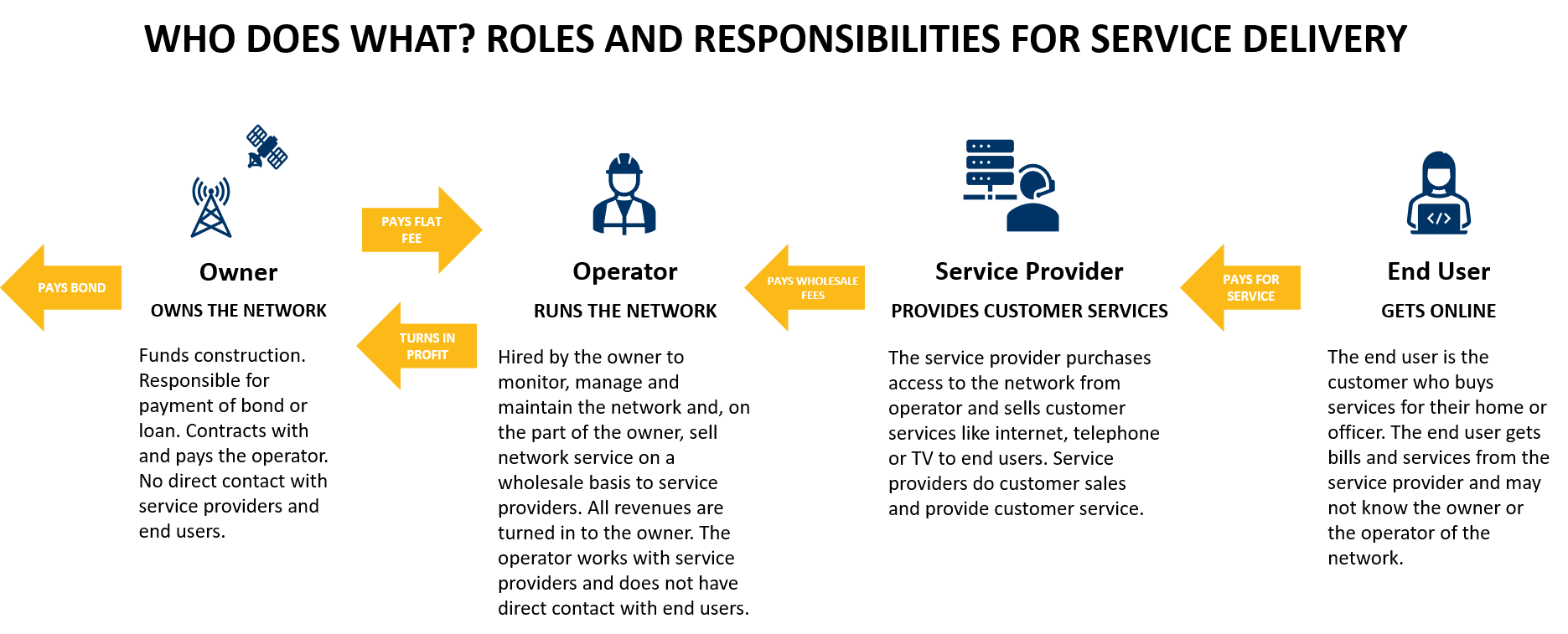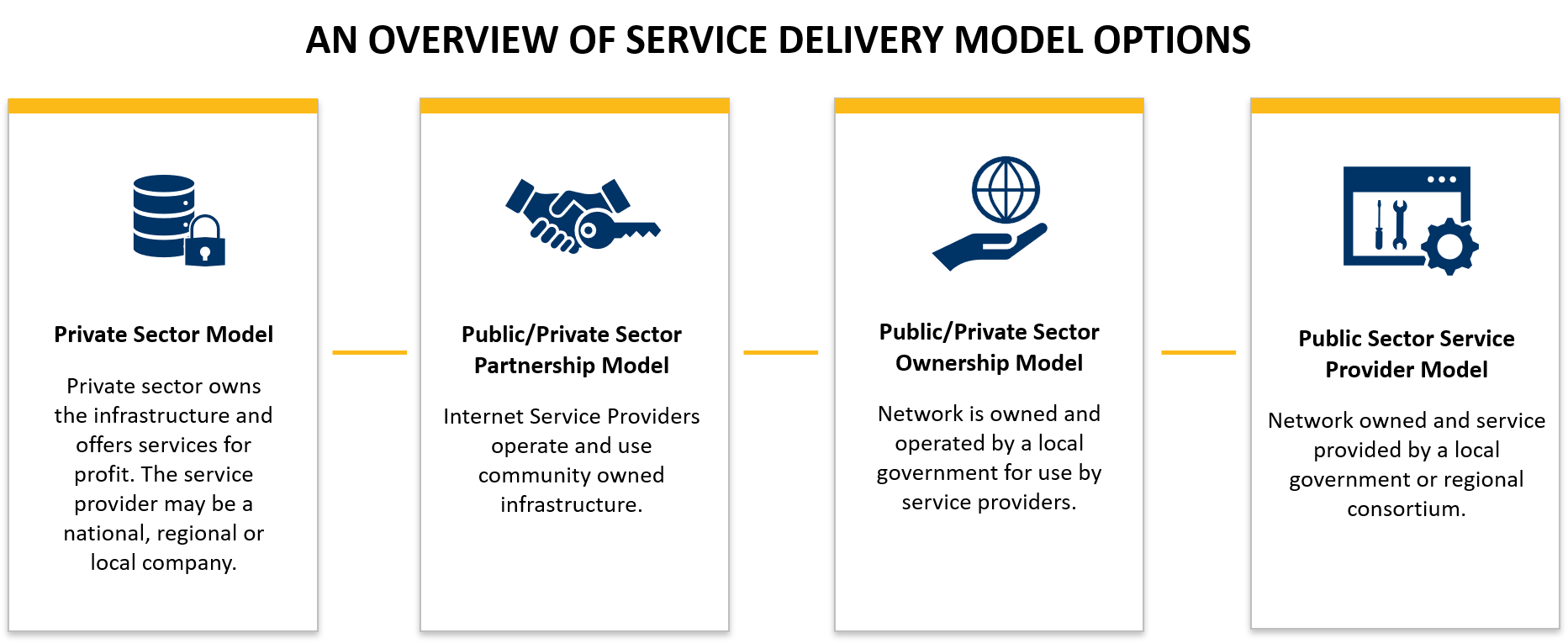Service delivery

There is no single correct way to connect a community. Selecting the best service delivery model and partnership structure depends upon the resources and needs of your community.
On this page
- The economics of broadband
- Life cycle costs of broadband services
- The key factors of a business case
- How to prepare your community for connectivity investment
- Components of delivery
- Service delivery model options
- Next steps
As you begin to think about the best way to connect your community, there are several important considerations to be made. These include:
- Technology: What type of technology do you want to use?
- Ownership: Who will own and maintain the infrastructure?
- Service provision: Who will provide services over the infrastructure?
- Business model: What will be the revenue and cost model to support broadband services?
This section presents the basics of the economics of broadband. It also gives an overview of the options for building and keeping a broadband network in your community. The goal is to give planners the info they need. It will start talks on the cost and possibility of broadband.
Economics of broadband
Providing internet in rural areas is hard. It's also hard in remote areas. The economics of building and running broadband networks is one key factor.
Internet service is a commercial commodity. The major carriers focus on building new infrastructure. They do this to meet rising demands and make the most of their investment.
The return on investment for broadband capital projects in rural and remote areas may make it difficult to attract private sector investment. This is due to the low number of potential customers and the physical distance that must be covered.
Life cycle costs of broadband services
Like all infrastructure projects, there are two broad categories of expenses for broadband:
- Capital costs: Fixed, one-time expenses needed to buy or lease the land, buildings, labour, equipment, and materials required to build the actual network. Capital costs include connections to households and businesses (i.e. last mile). They can also include start-up costs for obtaining permits and make-ready work on infrastructure (e.g. poles)
- Operations and maintenance costs: Ongoing expenses required to maintain service over time. This includes the costs to maintain and upgrade equipment and network capacity as infrastructure ages or user demand increases. It also includes human resources costs, such as for technical, administrative, marketing, and other staff to support the operation of a network (e.g., marketing and outreach, maintaining a help desk, setting up billing systems)
Most funding programs offer grants to cover the capital expenses of a broadband solution. But it is important to consider both types of expenses when planning connectivity infrastructure projects.
Key factors of a business case
Communities may have different challenges, but all face a similar economic one. Service providers decide where to build connectivity. They do this according to market signals.
Service providers will invest in connectivity infrastructure. They will do so if there is a viable business case for it. Several factors can influence the business case of a community for the deployment of broadband services:
- Density of population
- Geographical spread and topography
- Current and future customer demand
- Existing infrastructure, including distance to Points of Presence (PoP), connection to the backbone, and availability of dark fiber
- Type of technology
- Red tape challenges, such as rights-of-way, permitting procedures, and zoning
You may want to talk to multiple carriers and service providers. You can partner with them to coordinate the best solution for your community. Major carriers may build the main infrastructure. They can work with smaller providers for the last-mile connection.
Contact the regional manager of your local service provider early in the connectivity planning process. They can help you determine what local government can do to eliminate barriers to make it cost effective for service providers to build infrastructure in your area.
Prepare for connectivity investment and deployment
It is important to understand how the policies and practices of local governments affect the economics of broadband and encourage broadband deployment.
There are many steps you can take to reduce service delivery costs and increase the potential to attract new investments in service upgrades and expansions:
- Leverage community assets: Municipalities and regional districts own many assets that can be used to help current and new service providers to save costs. This can include physical assets like rights-of-way, utility poles, underground conduits, and buildings
- Adopt a Dig Once policy: Dig Once policies aim to lower the cost of future broadband deployment. They require that conduit and fiber optic cables are installed as part of other construction projects, such as road maintenance. Construction costs represent the most expensive component in a broadband deployment budget. A Dig Once policy is a low-cost and low-risk option for local governments who want to reduce the cost of future digital infrastructure
- Simplify your regulatory and permitting practices: Complex permitting processes and unpredictable waiting periods for approvals can discourage investment in your community. Reducing ongoing regulatory costs can encourage service providers to expand and upgrade their network
- Aggregate demand: Working with other local governments to aggregate demand can help make the population base cost more manageable
Components of delivery
Broadband networks involve three components: Infrastructure, network operations, and service providers.
- Infrastructure: Refers to the physical components of the network, such as fiber optic cables or wireless towers. The owner of the infrastructure is responsible for funding the construction of the network
- Network operations: Refers to the operation and administration of the infrastructure. The operator of a network is responsible for monitoring and managing the performance of the network
- Service provider: refers to the company providing provision of services to customers
Each component of service delivery is essential to provide connectivity to citizens, businesses, and organizations of a community. However, the owner, operator and service provider can all be different entities.

The owner of the network pays for the construction of the infrastructure. They can either operate the network themselves or they can contract and pay someone else to run the network for them.
The operator then manages and maintains the network to ensure good performance. The operator also sells access to the network infrastructure and service to service providers. All revenues are then turned into the owner.
After purchasing access to the network infrastructure from the operator, the service provider sells services to customers like internet and telephone services. They also provide customer service and tech support if needed. Service providers are the only ones having direct contact with end users, who may not even know who the owner and operator of the network is.
There is no single approach to determine who should be responsible for each component of service delivery, and there are many roles that local governments can play in broadband connectivity.
Service delivery model options
There are many roles that local governments can play in broadband connectivity. Each option is unique in its distribution of responsibilities among the participating parties.
One option is to let the market operate on its own, which is what has largely existed to date. In this case, private companies own, operate, and deliver services to residents and businesses. Another model is when local governments own and operate their own broadband networks. In between these two scenarios are various forms of partnership between local governments and private companies to share the risks and rewards of an investment in services. For example, local governments can advocate and provide support for projects, make municipal and regional assets available, offer financial support, or get involved in ownership.

Next steps
Contact information
connectedcommunities@gov.bc.ca
